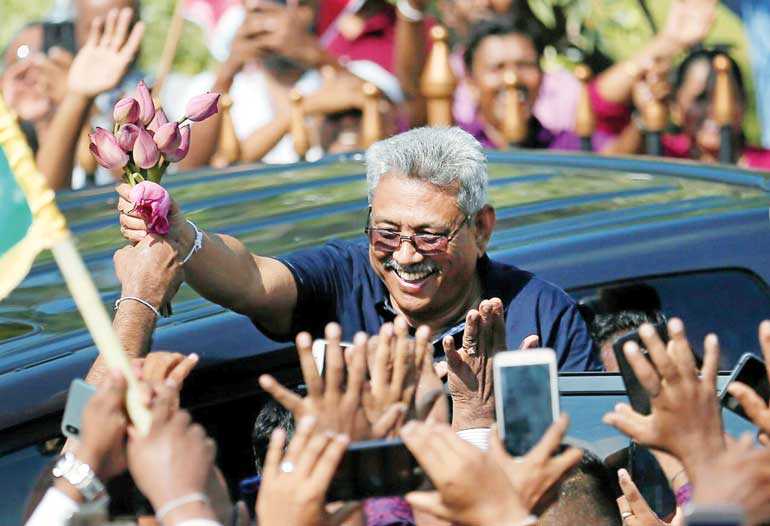Friday Apr 18, 2025
Friday Apr 18, 2025
Thursday, 12 December 2019 01:19 - - {{hitsCtrl.values.hits}}

The President said that he was the President of all Sri Lankans, including the people who did not vote for him. The election results were highly polarised along ethnic lines.
It is important to note that minorities did not vote for the extremist candidates of their ethnicities. They voted overwhelmingly for a Sinhala Buddhist. This was the situation at the last Presidential Election as well. This time the trend continued with the sharpening of this polarisation. This election was canvassed mainly on the grounds of national security and ethnicity. Ironically, if Sri Lanka needs national security at this point in history, it needs to harmonise the different ethnicities and religions, rather than dividing them. Therefore, the country currently has the wrong mindset.
Democracy is the rule of the majority. If the majority tries to suppress the needs of the minority, democracy will deteriorate to the level of a dictatorship of the majority. Sri Lanka was in this situation for long time and sometime back it tried to march towards pure dictatorship. It was foiled and thereafter democratic freedom was established. However, it did not return to the status of pure democracy.
The President stated that he would not address the political aspirations of the Tamils, but he would certainly address their economic aspirations since the Sinhalese would not be opposed to the development of predominantly Tamils areas. He thinks that in this way their political aspirations will fade away. In other words, the assumption is that the root cause of the problem is an economic one. It is not. 
The people of Hong Kong launched a massive protest campaign against Chinese rule. Hong Kong is economically sound, but they selected to protest against the Chinese-backed extradition law by compromising their economic growth. Scotland is enjoying asymmetrical power sharing in Great Britain. They can decide whether to leave Great Britain or not, but they decided to stay at the last referendum. Catalonia is a wealthy region in Spain, having a separate parliament and contributing to 19% of Spain’s GDP. There is a widespread belief among Catalonians that the central government takes much more from them in taxes than it gives back.
Therefore, low economic conditions may not be the reason. On the other hand, when the economy grows it may be more difficult to suppress the political aspirations of Tamils, contrary to the belief of the President. What the President is not saying is that the political movement he represents worked intentionally to uphold Sinhalese chauvinism and took political advantage of that. From S.W.R.D. Bandaranaike onwards, Opposition political parties worked this way. Only Chandrika Bandaranaike Kumaratunga and Ranil Wickremesinghe did not follow this strategy. They have their own shortcomings and deficiencies, but they did not try to take political advantage of the national question.
Mahinda Rajapaksa, a former President, got the best opportunity to solve this question as the leader who ended the war. Unfortunately, he avoided that.
Yitzhak Rabin was the Commander-in-Chief of the Israel defence forces during the six-day war in 1967. When he was the Prime Minister in 1994, he signed the Oslo-backed Israel-Palestinian peace agreement which paved the way for him getting a Nobel Peace Prize. However, he was subsequently assassinated by a person who opposed the peace treaty. Mahatma Gandhi, who was a key figure of Indian independence and proponent of an end to ethnic, religious and caste-based discrimination in India, was also assassinated as a result of his stand in ethnic riots in 1947. The former President may have thought that it was better to stay alive rather than getting the Nobel Prize.
Past ethnic harmony
This was not always the case. History teaches us a different lesson. For millennia in this country we did not have ethnic conflicts until 1915. Conflicts and wars were waged among kings and princes. They were concerned about power and not ethnicity. There were many Sinhalese in the army of Elara. The Mahavamsa praised Elara, saying that he ruled “with even justice toward friend and foe, on occasions of disputes at law”. Magha, who ruined our civilisation and paved the way to shift the kingdom to the South in the 13th Century, was not a Tamil. Sinhalese kings sought the support of the Pandyans against the Chola invasions.
Sinhalese and Muslims lived in this country in harmony for over a millennium. During the rule of Sinhala kings, Muslims served in royal courts and advised their rulers on international affairs and trade. They also served in Buddhist monasteries and were allowed to build their mosques on temple premises. Sinhala kings allowed them to settle in the Kandyan District to save them from the influence of Western invaders.
This situation changed in the late 19th Century with the advent of the Buddhist revival movement. During that time, Sinhala Buddhists were downtrodden and the hegemonic domination of society was with the Christians and trade was with the non-Sinhalese. Unfortunately, the Buddhist revival program, which was initially directed against the Christians, was subsequently redirected at other ethnicities as well. This was the beginning of ethnic conflict in this country. Contrary to this situation, India managed to direct its independence struggle against the British, uniting all the religions and ethnicities of the country.
Therefore, this is a political movement. This was used by the Opposition leaders starting from Bandaranaike to gain power. Kumaratunga changed this. The Sudu Nelum movement was able to change the contaminated Sinhalese mindset to a great extent. Therefore, Mahinda Rajapaksa had the opportunity to create a paradigm shift in the country’s politics. His failure was a misfortune to him and the country.
Gotabaya Rajapaksa is now also presented with a similar opportunity. However, it is not as great an opportunity as his brother received. The reason for this is that the stirring of Sinhalese chauvinistic sentiment also contributed to his victory at the election to a great extent. Bandaranaike, after his victory in 1956, tried to do right by the Tamils but he could not face the pressure of the people led by Buddhist Bhikkus. He was a liberal democrat. Gotabaya Rajapaksa is not a liberal democrat. He is an authoritarian leader as requested by the Bhikkus themselves.
The only constitutional concession the Tamils got was granted as a result of the Indo-Lanka pact which was signed with the intent of one person, with the opposition of his Prime Minister and senior ministers and all the political parties other than Tamil ones, with the imposition of a curfew and finally a physical attack on the Indian Prime Minister.
Maithripala Sirisena and Ranil Wickremesinghe did not offer political leadership to the process of making a new Constitution. The process has reached a considerable level with the support of all Members of Parliament.
Indian precedent
The Sinhalese fear a political solution without any valid grounds. They think that if some autonomy is given to Tamils, they will ask for a separate state. This is incorrect. India provides an example to negate that belief.
By the time it become an independent country, India had demarcated the borders of Southern Indian states based on the areas acquired from Maharajas and the hitherto followed borders of the British. There were requests for a separate Tamil state in particular, and a separate state for all the people who spoke Dravidian languages in general. India started the re-demarcation of the borders of its Southern states in 1953 and it continued this until 1956.
The states of Hyderabad and Andra were combined and Telugu-speaking Andra Pradesh was created. Travancore-Cochin State and the Malabar Provinces of the Madras Presidency were combined and the Malayalam-speaking state of Kerala was created. The Tamil-speaking Southern Provinces were amalgamated with the Madras Presidency which was renamed Tamil Nadu in 1968. The Kannada-speaking provinces of the state of Hyderabad and western Bombay state were combined with the state of Mysore. This was renamed Karnataka in 1973.
With these changes and with the constitutional prohibitions for separation, the demand of the separate Tamil state faded away. What they wanted was separate identities for respective ethnicities and not separate states. Therefore, it was proved in India that the demarcation of provinces based on language and ethnicity would run down demands for separate states. This is quite contrary to the popular belief in the south of Sri Lanka.
It is the task of the country’s concerned civilians and civil society to convince the majority Sinhalese that if the Tamils are allowed to fulfill their political aspirations this will not pose any danger to the territorial integrity of the country. They have to convince the President that without doing this, forging forward toward economic prosperity alone is senseless, and this is not a betrayal of the Sinhalese community. This is swimming against the stream.
Discover Kapruka, the leading online shopping platform in Sri Lanka, where you can conveniently send Gifts and Flowers to your loved ones for any event including Valentine ’s Day. Explore a wide range of popular Shopping Categories on Kapruka, including Toys, Groceries, Electronics, Birthday Cakes, Fruits, Chocolates, Flower Bouquets, Clothing, Watches, Lingerie, Gift Sets and Jewellery. Also if you’re interested in selling with Kapruka, Partner Central by Kapruka is the best solution to start with. Moreover, through Kapruka Global Shop, you can also enjoy the convenience of purchasing products from renowned platforms like Amazon and eBay and have them delivered to Sri Lanka.
Discover Kapruka, the leading online shopping platform in Sri Lanka, where you can conveniently send Gifts and Flowers to your loved ones for any event including Valentine ’s Day. Explore a wide range of popular Shopping Categories on Kapruka, including Toys, Groceries, Electronics, Birthday Cakes, Fruits, Chocolates, Flower Bouquets, Clothing, Watches, Lingerie, Gift Sets and Jewellery. Also if you’re interested in selling with Kapruka, Partner Central by Kapruka is the best solution to start with. Moreover, through Kapruka Global Shop, you can also enjoy the convenience of purchasing products from renowned platforms like Amazon and eBay and have them delivered to Sri Lanka.